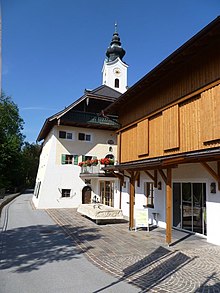Cultural opportunities
The museum's centerpiece is the beautifully restored forge of the former Bachschmied family Reischl, which is now a show-forge. In the former horseshoe chamber you will find the complete set of horseshoes Ebner family from Loig. Space on the first floor provide insight into the lifestyle of the 19th century and remember specifically to the Bachschmiede son Jakob Lechner, a former professor at the Vienna Military Veterinary Institute.
In the grown culture house is a museum that is dedicated primarily to the Salzburg-Bavaria topics. A first exhibition was referring 2008 to 1809 - Napoleon's army before Salzburg (Fourth Napoleonic War), a current exhibition is dedicated to the coinage of the past 2000 years (from the Roman denarius for Euro - 2000 Year money in Salzburg and neighboring Bavaria), the next exhibition comes to Sacred folk Art from the surrounding region.
As the permanent exhibition The Roman Villa Rustica is presented in Loig in the museum, a Roman country house, which was discovered in 1815 in the village of Loig. Particularly impressive here is the copy of Theseus Mosaic. The originals of the mosaics found, the stocks of the Kunsthistorisches Museum in Vienna.
Also located in the museum collection of antique toys, which goes back to the collecting activities of Karin Gugg. The changing exhibited historical and contemporary toys provide insight into the cultural history of toys and toy industry in the growing of the 19th and the 20th century.
In an art gallery (foyer of the event location) are regular exhibitions of different artists presented (including Robert Roubin, Ute Födermayr, Käthe Perner).
The variable design Sepp Forcher Hall is the place of theater performances, lectures, cabaret performances (including Martina Schwarzmann, Vince Ebert, Kernölamazonen, Monika Gruber), the International Walser film festivals and concert events.

Berchtesgaden is a municipality in the district Berchtesgadener Land, Bavaria, in southeastern Germany, near the border with Austria, 30 km (19 mi) south of Salzburg and 180 km (110 mi) southeast of Munich. It lies in the Berchtesgaden Alps. South of the town, the Berchtesgaden National Park stretches along three parallel valleys.
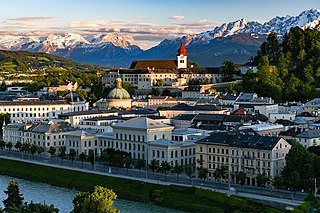
Salzburg is the fourth-largest city in Austria. In 2020, it had a population of 156,872.

Salzburg is an Austrian federal state. In German it is called a Bundesland, a German-to-English dictionary translates that to federal state and the European Commission calls it a province. In German, its official name is Land Salzburg, to distinguish it from its eponymous capital Salzburg. For centuries, it was an independent Prince-Bishopric of the Holy Roman Empire. It borders Germany & Italy.
Berchtesgadener Land is a Landkreis (district) in Bavaria, Germany. It is bounded by the district of Traunstein and by the state of Austria.

Rosenheim is a city in Bavaria, Germany. It is an independent city located in the centre of the district of Rosenheim, and is also the seat of its administration. It is located on the west bank of the Inn at the confluence of the rivers Inn and Mangfall, in the Bavarian Alpine Foreland. It is the third largest city in Upper Bavaria with over 64,000 inhabitants. Rosenheim is the economic centre and the busiest place in the region.

The Freud Museum in London is a museum dedicated to Sigmund Freud, located in the house where Freud lived with his family during the last year of his life. In 1938, after escaping Nazi annexation of Austria he came to London via Paris and stayed for a short while at 39 Elsworthy Road before moving to 20 Maresfield Gardens, where the museum is situated. Although he died a year later in the same house, his daughter Anna Freud continued to stay there until her death in 1982. It was her wish that after her death it be converted into a museum. It was opened to the public in July 1986.
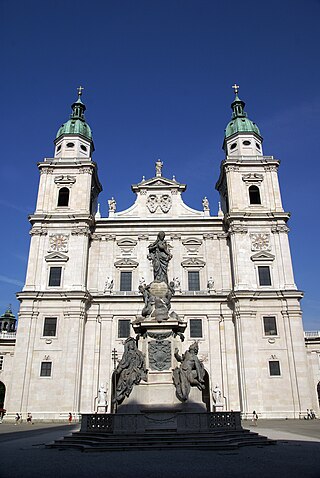
Salzburg Cathedral is the seventeenth-century Baroque cathedral of the Roman Catholic Archdiocese of Salzburg in the city of Salzburg, Austria, dedicated to Saint Rupert and Saint Vergilius. Saint Rupert founded the church in 774 on the remnants of a Roman town, and the cathedral was rebuilt in 1181 after a fire. In the seventeenth century, the cathedral was completely rebuilt in the Baroque style under Prince-Bishop Wolf Dietrich von Raitenau to its present appearance. Salzburg Cathedral still contains the baptismal font in which composer Wolfgang Amadeus Mozart was baptized.

The National Roman Museum is a museum, with several branches in separate buildings throughout the city of Rome, Italy. It shows exhibits from the pre- and early history of Rome, with a focus on archaeological findings from the period of Ancient Rome.

Shelburne Museum is a museum of art, design, and Americana located in Shelburne, Vermont, United States. Over 150,000 works are exhibited in 39 exhibition buildings, 25 of which are historic and were relocated to the museum grounds. It is located on 45 acres (18 ha) near Lake Champlain.
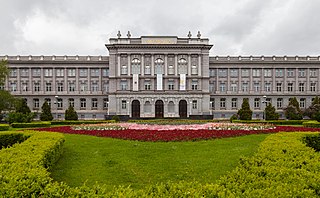
The Mimara Museum is an art museum in the city of Zagreb, Croatia. It is situated on Roosevelt Square, housing the collection by Wiltrud and Ante Topić Mimara.

The National Museum of Damascus is a museum in the heart of Damascus, Syria. As the country's national museum as well as its largest, this museum covers the entire range of Syrian history over a span of over 11 millennia. It displays various important artifacts, relics and major finds most notably from Mari, Ebla and Ugarit, three of Syria's most important ancient archaeological sites. Established in 1919, during King Faisal's Arab Kingdom of Syria, the museum is the oldest cultural heritage institution in Syria.

Bad Hindelang is a municipality in the district of Oberallgäu in Bavaria in Germany. As of 2008 it has a population of 4,915. Its sulphur spring was used for cures in the 19th century and today the municipality is a major health resort.

The Universalmuseum Joanneum is a multidisciplinary museum with buildings in several locations in the province of Styria, Austria. It has galleries and collections in many subject areas including archaeology, geology, paleontology, mineralogy, botany, zoology, history, art and folk culture. It is the oldest museum in Austria as well as the largest universal museum in central Europe with over 4.5 million objects in 13 departments and 12 locations in the Styrian cities of Graz, Stainz, Trautenfels, and Wagna. To reflect this status and its growth over the last two centuries, as well as to present a more recognizable image internationally, the Landesmuseum Joanneum was officially renamed to Universalmuseum Joanneum on 10 September 2009.

The Museum of Byzantine Culture is a museum in Thessaloniki, Central Macedonia, Greece, which opened in 1994.

The Bavarian State Archaeological Collection in Munich is the central museum of prehistory of the State of Bavaria, considered to be one of the most important archaeological collections and cultural history museums in Germany.

The Vienna Museum is a group of museums in Vienna consisting of the museums of the history of the city. In addition to the main building in Karlsplatz, the group includes some locations, numerous specialised museums, musicians' residences and archaeological excavations.
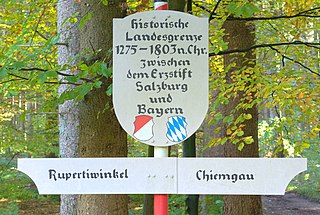
The Rupertiwinkel is a small historic region on the southeastern border of Bavaria, Germany. Part of the Archbishopric of Salzburg until the early 19th century, it is named after the first Salzburg bishop Saint Rupert (c.660–710), apostle to the Duchy of Bavaria.

The Rheinische Landesmuseum Trier is an archaeological museum in Trier, Germany. The collection stretches from prehistory through the Roman period, the Middle Ages to the Baroque era with a strong emphasis on the Roman past of Augusta Treverorum, Germany's oldest city. Its collections of (local) Roman sculptures, Roman mosaics and frescos are among the best in Germany.
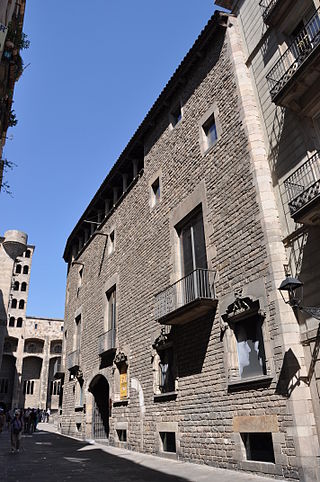
The Museum of the History of Barcelona is a history museum that conserves, researches, communicates and exhibits the historical heritage of the city of Barcelona, from its origins in Roman times until the present day. The museum's headquarters are located on Plaça del Rei, in the Barcelona Gothic Quarter. It also manages several historic sites all around the city, most of them archaeological sites displaying remains of the ancient Roman city, called Barcino in Latin. Some others date to medieval times, including the Jewish quarter and the medieval royal palace called the Palau Reial Major. The rest are contemporary, among them old industrial buildings and sites related to Antoni Gaudí and the Spanish Civil War.

Mozartplatz, formerly known as Michaelsplatz, is a square in the historic centre of Salzburg in Austria. In the centre of the square is a statue in memory of the composer Wolfgang Amadeus Mozart, who was born in the city and after whom the square is now named.
